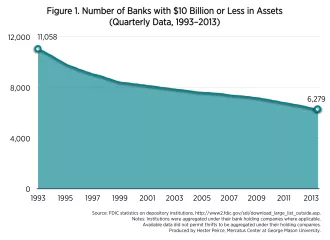- | Academic & Student Programs Academic & Student Programs
- | Financial Markets Financial Markets
- | Working Papers Working Papers
- |
Small-Business Financing after the Financial Crisis: Lessons from the Literature
Small businesses feature prominently in the US economy because they employ about 50 percent of the workforce and pay about 50 percent of American wages. Also, small businesses are often a source of innovative ideas that can drive growth. To the extent that access to finance plays a role in bringing those ideas to the real economy, small-business finance remains important for the future of the economy. Yet new financial regulations arising from the Dodd-Frank Act that were intended to stabilize the banking industry after the 2008 financial crisis may be unintentionally limiting small businesses’ access to credit.
In a new study from the Mercatus Center at George Mason University, researchers Stephen Matteo Miller, Adam Hoffer, and David Wille provide a review of the latest academic research into the major sources of capital used by small businesses in the United States and summarize the major trends and challenges that small-business owners face in obtaining capital today.
THE IMPORTANT ROLE OF FINANCIAL SERVICES
Bank credit plays an important role in the capital structure of US small businesses both at the time of startup and as the small business matures.
- Owner capital is not the only source of financing for new businesses. This statement runs contrary to standard theories of small-business financing, which predict that the owners of new firms are limited in their access to traditional loans, forcing them to rely on their own capital and financing from their family and friends.
- New business owners obtain credit from banks. But while owner equity is indeed an important source of capital for these small firms, especially at the time of startup, research shows that small-business owners are able to obtain credit from the traditional 2 banking industry in the form of both consumer financial products (like credit cards) and business loans.
The financial services industry thus plays a vital but underappreciated role in financing small firms—a role that has important implications for how new financial regulations may be impacting small-business owners’ access to credit.
SMALL-BUSINESS FINANCING REMAINS WEAK AFTER THE 2008 FINANCIAL CRISIS
Small-firm financing still remains less robust than before the Great Recession. Surveys of smallbusiness owners show, at best, a mixed picture of small-business owners’ use of capital today and their expectations for access to financing in the future. Small-business lending in particular is still well below its precrisis peak, even as total business lending has fully recovered. The proportion of small-business owners who say they are always turned down for credit is still above its average before the crisis.
While the uneven recovery in small-business financing may reflect weaker demand for capital, recent research indicates that postcrisis financial regulation is an important factor impacting small businesses’ access to financing, particularly bank credit.
KEY FINDINGS: THE UNINTENDED CONSEQUENCES OF FINANCIAL REGULATION
Dodd-Frank was intended to stabilize the banking industry after the crisis, but new regulations arising from it may be unintentionally limiting small businesses’ access to credit. Recent studies on this topic point to at least three ways in which these regulations impact small-business financing:
- There are higher compliance costs at banks. Increased scrutiny, mandatory changes to banks’ capital structure, and regulatory uncertainty have made small-business lending less profitable relative to other types of lending.
- There is a disproportionate impact on small banks. While small banks were supposed to be shielded from the higher costs of new financial regulations, surveys of small-business executives show they are still spending more on compliance. This is a concern because banks with under $10 billion in assets issue about half of all small-business loans in the United States.
- There are increased costs of credit. There is evidence that new regulatory burdens are increasing the costs of credit for the small-business owners who do obtain it, particularly the costs of the consumer financial products that many small firms rely on like personal loans and credit cards.
As a result, a new FinTech industry is emerging, composed of entrepreneurs who are facilitating financing through new digital intermediaries. Start-ups offering so-called marketplace lending, peer-to-peer lending, and crowdfunding are increasingly courting small-business owners as banks retreat from this market. But pending regulation of this new industry will dictate how much of a role it will play in small-business financing in the future.
Additional details
This article was published in the Journal of Entrepreneurship and Public Policy, Volume 6, Issue 3.


